737 Mastiffs; Dogges not Molossers
MASTIFFS ARE DOGGES
by David Hancock
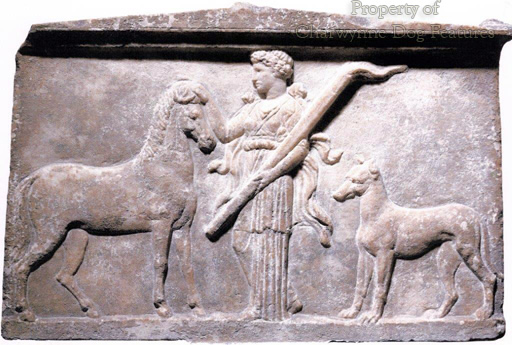 Time and time again, in books and magazines, especially on the continent and in North America, the mastiff group of dogs is blurred with the molossers, or dogs claiming ancestry with the huge dogs of the Molossi people. The "gripping" or "holding" breeds like the Bulldog, the Bullmastiff, the Dogue de Bordeaux, the Neapolitan Mastiff, the Fila Brasiliero and the Perro de presa Canario have become "molossers" in spite of any historical evidence to that effect. I have searched the literature, art galleries and museums of Greece and Italy without avail. But there is evidence in abundance of big Molossian dogs taking two distinct forms: a flock guardian and a hound of the chase.
Time and time again, in books and magazines, especially on the continent and in North America, the mastiff group of dogs is blurred with the molossers, or dogs claiming ancestry with the huge dogs of the Molossi people. The "gripping" or "holding" breeds like the Bulldog, the Bullmastiff, the Dogue de Bordeaux, the Neapolitan Mastiff, the Fila Brasiliero and the Perro de presa Canario have become "molossers" in spite of any historical evidence to that effect. I have searched the literature, art galleries and museums of Greece and Italy without avail. But there is evidence in abundance of big Molossian dogs taking two distinct forms: a flock guardian and a hound of the chase.
First of all, who were the Molossi? They were an Epirote people, ascendant from 500 to 300 BC. Their tribal kingdom stretched from north of Mount Pindus to the headwaters of the Thyamis river, on the Greek mainland, opposite Corfu. Other tribes rallied to them in their battles with the Illyrians from the north. The Molossi were Greek-speaking, sheep-owning, mainly mountain dwellers who cultivated valleys, occupying the wettest part of Greece, with heavy snowfalls in winter and many villages above 5,000 feet in altitude. The Molossi came originally in migrations from the north. In 167 BC Molossia was captured by the Romans and a sizeable proportion of its people enslaved. In happier times, two hundred years earlier, the Molossi had issued their own silver coinage with, as its emblem, the Molossian hound, a tribute to its fame.
But what does recorded history tell us of the dogs of the Molossi? Aristotle, 384-322 BC, wrote of..."The Molossian breed, moreover, the hunting kind, differs in no way from the rest...But famous above all for courage and hard work is the progeny of Molossian crossed with Laconian". He therefore acknowledges more than one kind and recommends an outcross ! But he also recorded that "The Epirote dogs are the largest of all." Varro, born in 116 BC, wrote: "Dogs are called after the district that they come from, as Laconian, Epirot, Sallentine...", going on to differentiate between butchers' dogs and hunting dogs. Grattius rated British dogs above "the well-known Molossian hounds".
Theodore Gaza, an eminent Greek scholar of the fifteenth century, refers to "...the Colophonian breed and that of the Castabalienses, who had regiments of dogs that fought in the Van of War", with Pliny as his source. Aelian, living in the early part of the third century AD, wrote that: "The Hyrcani and Magnesii used to be accompanied into battle by their dogs". Neither of these authorities wrote of the Molossian dog as a wardog. Grattius writes of a dog of the hunting kind: "...born...in the country of the Molossi which is eager and keen; and which runs forward and backward with great speed". But the fiercest dogs he describes as Hircani or Indian.
The Hyrcani lived in an area known as Seres or Seri (sometimes as Gurgan), south-east of the Caspian Sea, where today the modern states of Iran, Turkmenistan and Afghanistan meet. Hyrcania was part of Parthia in the Persian Empire. In his 'The Golden Age of Persia' of 1975, Richard Frye writes: "One should not fail to mention Gurgan (Arabic: al-Jurjan), ancient Hyrcania, a fertile province to the east of the Caspian Sea, where from ancient times settled Iranians had to defend their lands against nomads from the northern steppes." Inevitably this was where valuable goods, including hounds and horses, were traded between the plain dwellers in settlements and the nomadic tribes from the north and north-east. Hyrcania embraced mountainous forests, extensive plains, lakes and rivers, with wild life ranging from tigers, bear, hyenas, wolves and wild boar to wild horses, asses, buffalo, deer and antelope. All the traditional quarry for hunting mastiffs and holding dogs. 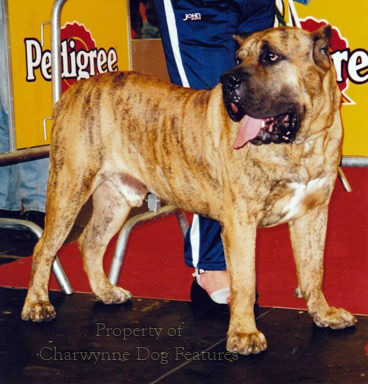
The Sumerians settled in Mesopotamia in the fifth millennium BC and thrived until the early second millennium BC; interestingly their language resembled the Mongol speech, being reminiscent of the Ural-Altaic languages. Their early rulers maintained close ties with the city-state known as Attala, believed to have been located in the region of the Caspian Sea. Artefacts depicting broad-mouthed dogs have been found at Lagash (now Shippurla) and Larsa (biblical Ellasar, now Senkerah) and dated at two thousand BC. Only in the twentieth century did scholars discover the importance of Sumer as an advanced civilisation; it may well be that the Sumerians migrated south-west from Tartary taking their huge hunting mastiffs with them. Certainly their artefacts of mastiff-like dogs are the oldest ever found.
In this part of the world, Persia was a central Asian power, the link between east and west. The Babylonians were hunting with broad-mouthed hounds two thousand years before the Molossi were even known. The Assyrians were hunting with broad-mouthed hounds one thousand years before the Molossi were known. Despite this scholars with no knowledge of dogs still attribute the origin of the mastiff group to a small isolated group of mountain people in Epirus, rightly famous for a different type of dog. Scholars translating Gaza, Grattius, Varro and Aristotle, especially in the Middle Ages when the word mastiff meant any and every huge hefty dog, are the source of much misinformation. They have misled any number of breed researchers who read the word mastiff as synonymous with the name of the modern pedigree breed.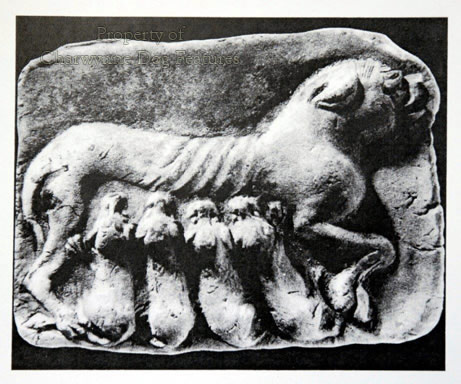
Take for example this quote:
"When half enraged,
The rude Molossian mastiff, her keen teeth
Baring tremendous,"
Such a quotation is so often used, or rather misused, by mastiff devotees to prove a point on the breed's heritage. But if you look at the Latin original:
"Inritata canum quom primum magna Molossum
Mollia ricta fremunt, duros nudantia denteis,"
you can quickly see that the word mastiff is missing. Once scholars started perpetuating the idea that a huge fierce dog from Molossia is a mastiff, their subsequent words fed the tendentious researches of breed historians. In his 'The History of the Mastiff' of 1886, the Rev MB Wynn gave the view that: "Many people therefore erroneously think the word molossus necessarily means a mastiff, whereas the Greeks only became acquainted with the true mastiff about the time of the Macedonian conquest at 336BC." That is a telling observation which I wholeheartedly support.
Similar misapprehensions have led Tibetan mastiff fanciers to misapply the records of Marco Polo's travels. He allegedly referred to "mastiffs as large as donkeys" but didn't use the word mastiff at all. His translators, scholars with no knowledge of dogs, did so. His record was of huge dogs, the size of local donkeys (smaller than ours) which "...are trained to hunt every type of animal; but particularly the huge and fierce wild oxen. There are many different kinds of hounds..." I would read this as meaning that hounds of the chase were variously employed to seize and pull down big game.
This part of the world, in those times, came under Kubla Khan. We also learn from Marco Polo that from October to March the court was provided with 1000 head of game per day. Two thousand men in red and another two thousand in blue, each colour supported by as many as 5,000 dogs, hunted in two lines spread out over a distance of a day's journey. The hounds walked, the hunters were mounted. Translators have referred to these dogs as mastiffs, implying big dogs, when they should have called them heavy hounds. Does anyone seriously think that the mastiff breeds of today so often linked by their owners with the Marco Polo reference could carry out such a feat? Many that I see in the show ring can scarcely manage a circuit or two. Yet mastiff breed researchers regularly claim links with such hounds entirely because the ignorant translators have misused the word mastiff.
Because steppe nomads long before the Great Khan, the Scythians and the Sarmatians, were illiterate and left little trace of their arts and crafts, we have tended to underrate their astonishing impact on other civilizations. Their mastery of the horse brought them over the Caucasus and Carpathians to provide cavalry for the Greeks and Romans and teach the Assyrians most of what they knew about the use of the horse. On their belt buckles and shields the elongated "S" denoted the dog. Before about 1500BC Egyptian hunters operated on foot but then the Hyksos arrived from the southern steppes with horse and chariot. From then on Egyptian noblemen had stables as well as kennels. The steppe nomads also had hounds with the capability of keeping up with the horses. So these were traded too.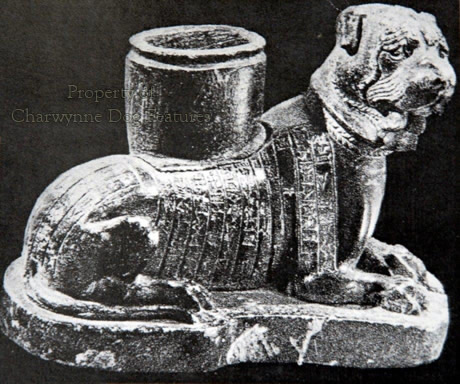
The Alans, probably the mightiest tribe of the Sarmatians at one period and famous horsemen, accompanied by huge hounds, reached well into Western Europe in their time. They also provided the cavalry for Roman legions in northern Europe. Topographical place names of Alanic origin appear in Poland, Slovakia, Serbia, Croatia, Germany, Georgia, France (e.g. Alencon), Spain and throughout the Roman Empire, including Britain. Their hounds were called 'alauntes' and developed into three types: 'alauntes gentle', hunting "mastiffs" and the great butchers' hounds, i.e., the catch dogs or holding and pinning dogs. Contemporary equivalents, by type not breed, for each of these would be: the Great Dane, the bullmastiff and the bulldog. The Alans settled in a number of countries, including Spain in 406 AD.
Spain, in the Middle Ages, produced the best alauntes. The 'war-dogs' of the conquistadores were alauntes; chroniclers referred to them as mastins, alanos and lebrels (the latter a strong-headed greyhound). The perro de presa (literally seizing dog) and perro de ayuda (literally aid or protection dog) were used ruthlessly by the advancing colonists, with perhaps around half a million natives being killed by such dogs. (The Portuguese used similar dogs called 'filas', meaning seizing dogs, perpetuated today in Brazil for example by the huge Fila Brasileiro breed). Dogs used in Spain more recently for bull or bear-baiting have been named alanos. There is abundant evidence that alauntes existed in France from very early times. In the 14th century, Gaston de Foix, who lived on the French side of the Pyrenees referred to them in his classic book on hunting. He differentiated between big hounds of the chase and huge "alauntes of the butcheries". They were quite clearly not the same type of dog used for both purposes, although both were used at the boar hunt, one to hunt, the other at the kill.
In Wales, the Ancient Welsh Laws, codified around 920 AD, refer to two kinds of "mastiff" (meaning huge dog): the 'Cadgi' or battle dog and the 'Gafaelgi' or gripping dog. There were clearly two different kinds of dog for such a distinction to be made. In northern and central Europe were the 'beissers' or heavy hounds, like the so-called boar-lurcher, for seizing the bigger quarry. I can find no reference at all to the Molossi using holding or gripping dogs despite the fact that such dogs were known in their time. There is however a multitude of references to wardogs, battle dogs and butchers' dogs being owned and used by other tribes e.g. the Hyrcani and the Magnesii.
Because the Molossian hound and the Molossian flock-guarding dog were fierce and at times savage (as Aristotle records) they were lumped together with the other "canes pugnaces or bellicosi". Statius wrote of the soldiers of the Molossi weeping over their faithful canine companions slain in the war. But the Molossi used their huge dogs as outpost sentries not as wardogs, as the Hyrcani did. Even in the last century, the Suliot dog (from the Suli mountains in Epirus) was used to guard outposts in the war between the Austrians and the Turks. It is highly significant that the Romans referred to the broad-mouthed dogs as Canes Pugnaces or Bellicosi and not Molossi.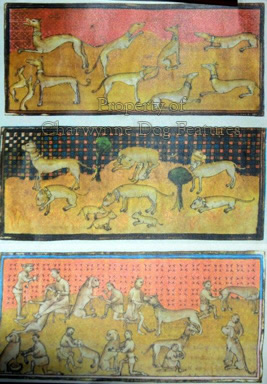
The French professor Pierre Megnin, in 1896, defined four basic canine skull structures: lupoides, braccoides, graioides and molossoides, and listed the breeds of dog identified then either in these groups or from a mixture of them. At that time Megnin was unaware of the Sumerian hounds or the pre-dynastic dogs of Hierakonpolis, but clearly knew of the Molossi. Felice Cesarino believes that some of the Saharan graffiti showing heavy-skulled dogs could be from the "grande fauna selvaggia" phase, ante-dating the Sumerians. Johan Gallant, President of the Africanis Society in South Africa, who pointed this out to me, shares my belief that an update of Megnin's classification is long overdue.
Blaine, writing in 1840, makes a number of points for me when he states that: "Linnaeus appears to have erred much in naming this variety (i.e. the Bulldog) Molossus...Much of the obscurity which attends the origin of the Bulldog has arisen from confounding him with the ancient account of other pugnacious dogs..." He then goes on to make rude remarks about the ignorance of translators "who could not distinguish a Bulldog from a cur". Wynn, writing forty years later, stated that: "Classical writers carelessly or for convenience called any and all dogs approaching anything like the dogs of Epirus in size or character by the common term molossus...classical writers used the word molossians at a later period to embrace the true mastiff and allied groups, and Dr Caius, Gesner, Linnaeus, and other naturalists followed the classical jumble. Therefore readers and translators should be very guarded how they render molossus as a mastiff, for the true molossian was...identical or almost so, with the modern Suliot boarhound." Scholars and natural historians have clearly compounded their own errors over many many years.
The Molossian dog took two forms: a big flock-guarding breed, rather like the Kuvasz of Hungary and the Pyrenean Mountain Dog of France, and a huge hound, perhaps perpetuated today by breeds such as the Great Dane and the Dogo Argentino. In Dr Smith's 'Classical Dictionary' of 1859, he writes "The Mollossian hounds were celebrated in antiquity, and were much prized for hunting." The mastiff group, the strong-headed, broad-mouthed breeds such as the Perro de Presa Canario, the Neapolitan Mastiff and the Dogue de Bordeaux have a quite separate Asiatic origin. The well-known "terra-cotta dog" of Asshurbanipal would be a fair representative of the prototypal mastiff family. Several of these statuettes have been found, bearing such names as "Tear the Foe" on the back of the collars. As already discussed, there are also canine artefacts from even older periods e.g. Lagash and Larsa.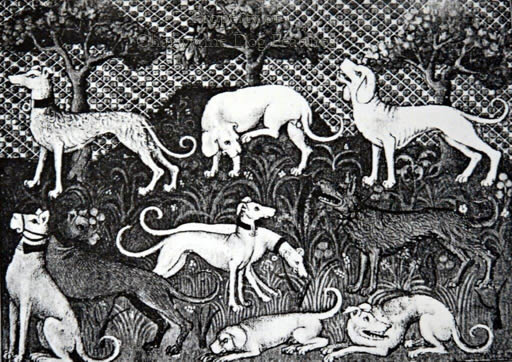
The first Lagash dynasty was from around 2500-2350BC; the Larsa people were ascendant in the early second millennium BC, i.e. four thousand years ago. In his much respected work 'The Sumerians, their History, Culture and Character' (University of Chicago Press, 1963) Samuel Noah Kramer records how "animal husbandry was supplemented by hunting, and there are texts recording the deliveries of deer, wild boars and gazelles." He also mentions accounts of 'successful hunting on the plain'. The Sumerian artefacts of broad-mouthed dogs, one of a bitch suckling four pups and the other of an alert lying dog could well be portrayals of mastiff breeds today. Why should the broad-mouthed breeds be robbed of two thousand years of their history by scholars who know little of dogs?
By an Asiatic origin however I do not mean one linked to the flock-guarding breeds like the so-called mastiff of Tibet. I consider the Tibetan mastiff to be misnamed and I can never understand why so many writers have linked this fine breed with the origin of the mastiff group. Why choose this breed? Why not go for another yak or sheep-protector/herder like the Bangara 'mastiff', the Bhotia, the Kumaon, the Bisben, the Powendah or the Caucasian Owtcharka. The flock guardians are not mastiffs in our modern sense of the word. Admirable breeds like the Kangal Dog, the Leonberger and the Estrela mountain dog must not be bred to the design of the broad-mouthed dogs. In this respect, St. Bernard fanciers have in my view already lost their way, now producing specimens quite unlike both their own ancestors and sister breeds of Swiss mountain dog.
Once breeders either ignore their breed's origin or get misled by false research (or ignorant translators!), then essential breed-type is threatened. The Germans call the Great Dane a German Dogge or mastiff; the consequence must not be square-headed, lower-slung dogs with all their weight on the forehand. Many books on the surviving mastiff breeds tell us plenty about the Deutsche Dogge, or Great Dane, and the French mastiff, the Dogue de Bordeaux. But not many tell us the story of the Englische Dogge, most prized hunting mastiff in Central Europe in medieval times. Until the thirteenth century in England, a mastiff-type dog was called a 'docga', an Old English word, still retained on mainland Europe as dogge in Germany, dogue in France, dogg in Sweden and dogo in Spain. The master-engraver Ridinger portrayed the Englische Dogge at the end of the 17th century. No one claimed them as a breed, dogs then being bred for function not form, and never to a closed gene pool.
Breed titles and breed histories are all too often misleading and they do matter. Loose groupings like Molossers are fine -- as long as they refer either to huge hounds of the chase or powerful flock guardians and not the seizing and holding or 'gripping' breeds. Even the ancient gripping breeds had to run with the mounted hunters; the Molossi bred magnificent huge dogs, but they were not mastiffs. But who is going to persuade the mastiff breed clubs and the FCI? Although I have persuaded the latter to include ‘dogues’ in their Group 2 section 2; they really are mastiffs in the precise use of the word. Precision matters if you breed for function!